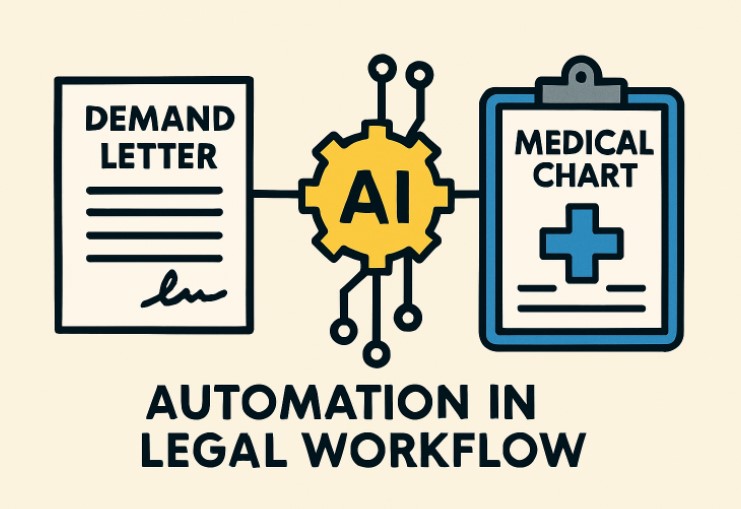Key Takeaways
- AI is rapidly reshaping how legal professionals handle case documentation and communication.
- Automated demand letters and medical chronologies can streamline processes, reduce human error, and save significant time.
- Integrating AI tools into legal workflows may lead to better client outcomes and increased efficiency for law firms.
- Staying updated on legal technology trends ensures law professionals can benefit from new advancements.
- Data security and ethical considerations should be considered when introducing AI solutions into legal practices.
Artificial intelligence is reshaping legal workflows by streamlining tasks that once required extensive manual effort. Demand letters, often time-consuming to draft, can now be generated quickly with AI, ensuring accuracy, consistency, and a professional tone tailored to each case. Similarly, medical chronologies—essential for personal injury and medical malpractice claims—are efficiently compiled, allowing attorneys to focus on strategy rather than data organization. These AI-driven tools reduce errors, improve turnaround times, and free up legal teams to dedicate more energy to client advocacy. By automating routine yet critical processes, firms save resources and enhance productivity and service quality. This innovation positions legal professionals to deliver faster, more effective results in an increasingly competitive landscape.
AI in the Legal Industry: A Rapid Shift
The legal sector is transforming significantly as artificial intelligence integrates into daily practice. Processes that once depended on lengthy manual review and endless paperwork are now streamlined with advanced automation tools. This evolution reflects a broader embrace of legal tech, helping firms become more resilient and adaptive in an increasingly competitive environment. Lawyers, paralegals, and legal assistants are shifting their focus from repetitive administrative tasks to more strategic, client-facing duties.
One of the most innovative advances is the AI demand letter. By leveraging AI, these demand letters automate extracting essential facts, summarizing case details, and creating persuasive correspondence grounded in legal precedent. This technology accelerates communication with opposing counsel and insurance companies and helps ensure that critical information is accurately conveyed every time.
How AI-Powered Demand Letters Work
Drafting demand letters has traditionally been a repetitive and time-intensive responsibility for legal professionals. AI-powered systems are redefining this process by scanning and interpreting large legal documents, evidence, and historical case outcomes. They can automatically identify and highlight key issues, organize facts, and suggest language that resonates with reviewers. With access to comprehensive legal databases, these platforms help create demand letters that are thorough, consistent, and highly effective at achieving desired outcomes.
The benefits for legal teams are substantial. Not only do AI-generated demand letters reduce human error, but they also allow attorneys to allocate more time to case strategy and client relationships. Automated drafting supports greater consistency, which is crucial for upholding the reputation and reliability of law firms. For additional insights on legal technology adoption, the Wall Street Journal covers the growing impact of artificial intelligence across the legal landscape.
Medical Chronologies Made Simple
Personal injury or medical malpractice cases require careful, detailed timelines constructed from complex medical records. This task can be arduous and prone to error when completed manually. AI-powered solutions now parse and organize medical documents, highlight injuries, and clearly map the sequence of events, enabling attorneys to spot crucial developments and inconsistencies quickly.

Law firms see enhanced accuracy and a more efficient discovery process by automating the construction of medical chronologies. AI minimizes overlooked facts and cuts hours from standard review times, allowing legal staff to focus on developing robust case theories and negotiations. According to research in the Forbes Technology Council, legal teams integrating AI for medical record review experience faster turnaround and improved client satisfaction.
Benefits of Integrating AI Tools
- Time Savings: Automation can cut document preparation time by up to 60%.
- Consistency and Accuracy: AI tools reduce inconsistencies, minimizing risks due to human error.
- Improved Client Service: Faster turnaround can lead to better outcomes and higher satisfaction rates.
- Document Management: AI solutions can organize files, highlight key facts, and maintain cohesive records for easy review.
Ethical Considerations and Data Security
Integrating AI into legal operations raises essential questions about confidentiality and ethical practice. Legal professionals manage extremely sensitive information, making compliance with data protection laws like HIPAA and GDPR non-negotiable. Law firms must ensure that any adopted AI platform implements robust encryption, regular audits, and transparent data-handling protocols.
Staying aligned with best practices is an ongoing effort. The American Bar Association’s Artificial Intelligence Initiative provides valuable guidance for maintaining responsible and secure implementation of AI-powered tools, helping legal professionals safeguard their practice and their clients’ trust.
Challenges and Solutions for Adoption
While the case for AI adoption in demand letter creation and medical chronology preparation is strong, transitioning is not without obstacles. Staff must be trained on new systems, resistance to workflow changes must be managed, and initial implementation may disrupt routines. However, successful firms tend to embrace incremental adoption through pilot programs and continuous feedback.
Regular training, open communication, and strong leadership can alleviate concerns and encourage buy-in. Law firms reporting the most success with AI-powered tools are those that pair innovation with a clear commitment to ethical and practical education for their teams.
Future Outlook: Staying Ahead in Legal Tech
The momentum of artificial intelligence in the legal industry is rapidly accelerating, reshaping how firms operate and compete. As AI-driven tools become more sophisticated, they provide opportunities to automate routine tasks, analyze complex data, and deliver insights with unprecedented speed. Firms that proactively monitor these advancements and strategically integrate them into their workflows are better positioned to enhance client experiences, streamline operations, and control costs. This adaptability creates a competitive advantage and establishes trust by offering faster, more accurate legal support. On the other hand, firms that resist or delay adoption risk inefficiency, higher expenses, and reduced client satisfaction. In a profession increasingly defined by agility and technology, staying current is essential for long-term success.
Final Thoughts
Adopting AI-powered solutions for demand letters and medical chronologies goes far beyond simply updating technology—it reflects a more profound commitment to delivering better outcomes for clients and raising the standards of modern law practice. These tools streamline repetitive, time-intensive tasks, reducing the risk of human error while significantly improving accuracy and consistency in case preparation. By leveraging secure and thoughtful AI integration, legal professionals can quickly generate documents, organize complex medical records more precisely, and free valuable time to focus on strategy and client advocacy. This not only enhances service quality but also boosts efficiency across the entire legal workflow. Ultimately, such innovation lays the groundwork for a forward-thinking, future-ready legal practice built on trust, expertise, and adaptability.







